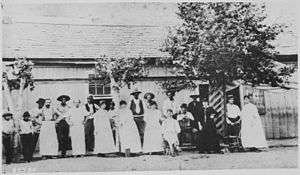Dance hall
Dance hall in its general meaning is a hall for dancing. From the earliest years of the twentieth century until the early 1960s, the dance hall was the popular forerunner of the discothèque or nightclub. The majority of towns and cities in the West had at least one dance hall, and almost always featured live musicians playing a range of music from strict tempo ballroom dance music to big band, swing and jazz. One of the most famous dance hall musicians was Glenn Miller.

.jpg)
Other structural forms of dance halls include the dance pavilion which has a roof but no walls, and the open-air platform which has no roof or walls. The open air nature of the dance pavilion was both a feature and a drawback. The taxi dance hall is a dance hall with a specific arrangement, wherein the patrons hire hall employees to dance with them.
Starting in the early 1930s, The Savoy, a dance hall in Harlem (a black neighborhood in New York City) was the first truly integrated building in the United States — for both the dancers and the musicians. "We didn't care about the color of your skin. All we wanted to know was: Can you dance?"[1]
The early days of rock n' roll were briefly played out in dance halls until they were superseded by nightclubs.
Texas
Texas has a high concentration of community dance halls, the largest number of them built by German and Czech immigrants.[2][3][4][5][6][7][8]
Sweden and Finland
In Sweden and Finland, open air dance pavilions have been used mostly in summer, but especially in Finland some have also been built to be used throughout the year. Formerly, the dance pavilions were often built at sites with beautiful landscape, for example by the lakes.[9][10]
See also
- Ballroom
- Dance club, the successor of the dance hall
References
- Burns, Ken. Jazz (2001), TV documentary
- Folkins, Gail. "Texas Dance Halls: History, Culture, and Community", Journal of Texas Music History, Volume 6, Issue 1, 2006.
- Whitson, Krista. Alter, Kevin, ed. "Dance Halls of Central Texas: Pre-World War II Wooden Structures". Austin, 2005. First in-depth survey of the dance halls populating central Texas. Documents 72 of these structures within a 150-mile radius of Austin through photographs and drawings
- Treviño, Geronimo III. Dance Halls and Last Calls: A History of Texas Country Music. Republic of Texas Press, 2002.
- "geronimotrevino.com". www.geronimotrevino.com. Archived from the original on 2003-03-28.CS1 maint: unfit url (link)
- Kolar, Roger Henry. Early Czech dance halls in Texas, 1975.
- Austin County Historical Commission, ed. Dance Halls of Austin County, Bellville: Austin County Historical Commission, 1993.
- Dean, Stephen, "Historic Dance Halls of East Central Texas". Arcadia Publishing. 2014.
- Hakulinen, Kerkko; Yli-Jokipii, Pentti. Tanssilavakirja: tanssista, lavoista ja lavojen tansseista. Helsinki: AtlasArt, 2007. ISBN 978-952-5671-07-0 (in Finnish)
- Yli-Jokipii, Pentti. "Changes in local communities: The cultural geography of Finnish open-air dance pavilions". Fennia 174:2. Helsinki: Geographical Society of Finland, 1996.
Further reading
- Cressey, Paul. The Taxi-Dance Hall: A Sociological Study in Commercialized Recreation and City Life (1923; reprint University of Chicago Press 2008), Famous study of Chicago in the 1920s.
- Nott, James. Going to the Palais: A Social And Cultural History of Dancing and Dance Halls in Britain, 1918-1960 (2015)
External links
- Dance Halls at Encyclopedia of Oklahoma History and Culture